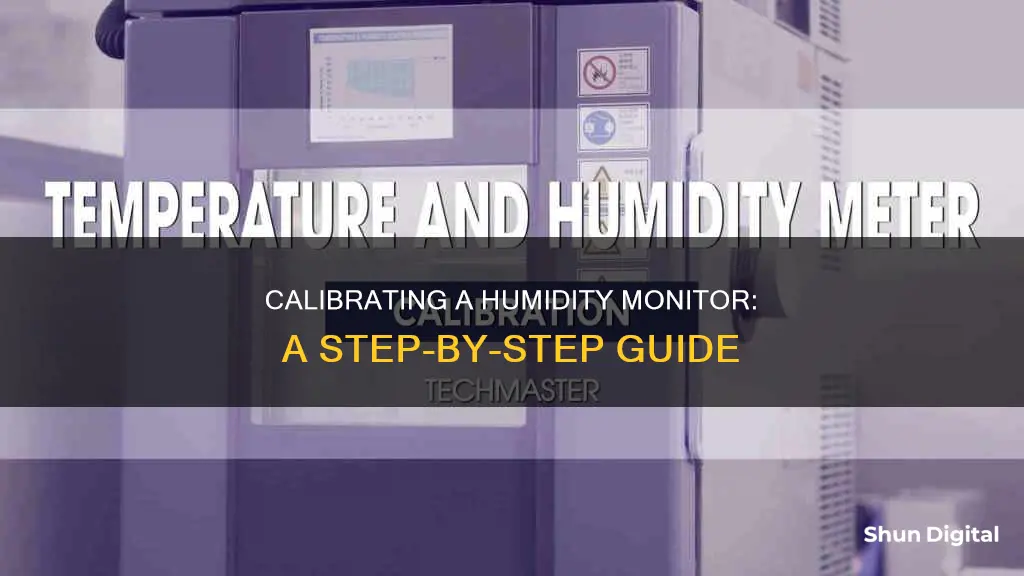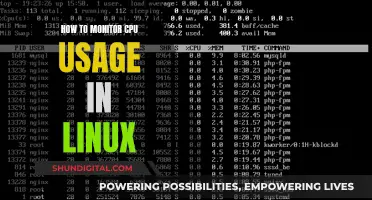
Calibration is essential to ensure the accuracy of humidity readings. Calibration is the process of fine-tuning a device to meet the manufacturer's specifications and ensure the measurements are accurate. This is particularly important in industries such as pharmaceuticals, semiconductors, chemicals, and food processing, where maintaining the correct temperature and humidity is crucial to prevent product spoilage.
There are several methods to calibrate a humidity monitor, including using a humidity generator/calibrator, a chilled-mirror probe, or the salt test. The salt test is a simple and inexpensive method that involves placing salt in a sealed container with the monitor, as salt exposed to air with a relative humidity of 75% will establish a relative humidity of precisely 75% inside the container. This provides a controlled environment to check the accuracy of the monitor and make adjustments as needed.
| Characteristics | Values |
|---|---|
| Calibration frequency | Depends on the type of sensor, how often it is used, and the operating conditions. |
| Calibration method | Using a humidity generator/calibrator |
| Calibration method | Using a chilled-mirror probe or hygrometer as a reference |
| Calibration method | Using the "saturated salt" method |
| Calibration method | Using another calibrated humidity sensor |
| Calibration method | Sending the sensor to a professional calibration service |
What You'll Learn
- Calibration methods: the salt test, chilled-mirror hygrometer, mixed-flow humidity calibrator, etc
- Calibration frequency: how often you need to calibrate your humidity monitor
- Calibration procedure: a step-by-step guide on how to calibrate a humidity monitor
- Calibration equipment: the tools and materials required for calibration
- Calibration issues: troubleshooting common problems with inaccurate readings

Calibration methods: the salt test, chilled-mirror hygrometer, mixed-flow humidity calibrator, etc
Calibration is important to ensure that measurements are accurate. This is especially important in industries such as pharmaceuticals, semiconductors, chemicals, aerospace, and food processing, where regulations require regular measurements of parameters such as temperature and humidity to prevent product spoilage.
Calibration Methods
The Salt Test
The salt test is a simple, accurate, and inexpensive way to calibrate a humidity monitor. This test is based on the fact that a wet sodium chloride (table salt) mixture will establish a relative humidity of precisely 75% in an enclosed space. Here's how to do it:
- Fill an empty bottle cap about 3/4 full of salt.
- Pour a small amount of distilled water into the cap to create a slurry. It should appear grainy and gooey, like wet sand at the beach.
- Place the lid inside a zip-lock bag, along with the hygrometer, with the display side up, near the bottle cap.
- Seal the bag without pushing any air out of it and place it in a stable temperature environment, ideally around 70°F.
- Leave the bag for at least 6-8 hours, but preferably 12-24 hours, to ensure the humidity inside the bag has stabilized at 75%.
- Read the relative humidity level on your hygrometer. If it reads 75%, you're done! If not, take it out of the bag and adjust it to 75% using the available method (buttons for digital, adjustment screw for analog).
Chilled-Mirror Hygrometer
The chilled-mirror hygrometer is a highly accurate humidity reference standard. It measures the dew point by chilling a polished metal surface until water begins to condense on it. An optical detection system then measures the reflected light from the mirror's surface. The dew point temperature is determined at this point. The chilled mirror hygrometer also has an air temperature sensor that can be inserted into the humidity chamber to calculate relative humidity accurately.
Mixed-Flow Humidity Calibrator
The mixed-flow humidity calibrator is a type of humidity generator that uses the split-stream method to control humidity. Dry gas is drawn into the generator and divided into two parts: one part is saturated with water vapour, and the other is mixed to achieve the targeted humidity output. The humidity depends on the humidity of the wet air and the mixing ratio. This type of calibrator is known for its speed and portability, making it suitable for both laboratory and field use.
Finding Mates: The Asian Water Monitor's Unique Strategies
You may want to see also

Calibration frequency: how often you need to calibrate your humidity monitor
Calibration frequency depends on the type of humidity monitor, its usage, and the operating conditions. It is recommended to calibrate a humidity monitor at least once a year. However, if the monitor is used in a harsh environment or is critical to an application, it may need to be calibrated more frequently.
For example, high humidity can affect the readings of a humidity monitor faster than low humidity. This is because high humidity means there is more water vapour present, which can cause condensation on the sensor and impact its accuracy. High humidity can also lead to corrosion or other damage to the sensor over time. Therefore, it is important to regularly calibrate and maintain humidity monitors in high-humidity environments.
Additionally, exposure to certain chemicals, such as vaporized solvents, outgassing tapes, adhesives, and packaging materials, may cause drift in the sensor or decrease its sensitivity. In such cases, more frequent calibration may be necessary.
It is also important to note that not all applications require the same level of accuracy in humidity measurements. If precise accuracy is not critical, calibrating the sensor as frequently may not be necessary. However, it is still recommended to periodically check the sensor's accuracy to ensure it is within an acceptable range.
Performance Evaluation: Controlling and Monitoring Strategies
You may want to see also

Calibration procedure: a step-by-step guide on how to calibrate a humidity monitor
Humidity monitors or sensors are commonplace and relatively inexpensive. They are used across a range of industries, from pharmaceuticals to food processing, to ensure product quality. Calibration is important to make sure that measurements are accurate and to maintain quality.
How to calibrate a humidity monitor
There are several ways to calibrate a humidity monitor. Some methods are more suitable for scientific purposes, while others are accurate enough for regular or consumer use.
The "saturated salt" method
This method involves using the chemical properties of certain salts (e.g. table salt or potassium chloride) to create a micro-environment of known relative humidity.
- Put some salt in a small container.
- Add a small amount of water to make the salt wet but not completely dissolved, similar to very wet sand.
- Place the container into an airtight container or sealed jar, along with the humidity monitor.
- Leave the container in the airtight container for approximately 24 hours.
- After a day, check the humidity reading on the monitor. If it differs from 75% relative humidity (RH), calibrate the sensor to show 75% RH.
This method can be done at home and is simple and inexpensive. However, it may not be accurate enough for scientific purposes.
Using a calibrated humidity sensor
If you have access to a recently calibrated humidity sensor, you can use this method:
- Place both the calibrated sensor and the sensor to be calibrated in a space with constant air humidity and temperature values.
- Allow some time to pass until the measurements on both devices remain constant.
- Check the reading of the recently calibrated sensor and adjust the other sensor accordingly.
Using a humidity generator/calibrator
This method is more suitable for scientific or industrial purposes. It involves using a humidity generator/calibrator to generate and measure humidity at a variety of temperatures and humidity levels. Here is a general overview of the steps:
- Fill the humidity generator humidifier reservoir with distilled water according to the manufacturer's directions.
- Remove any existing condensation from the chamber.
- Insert the device(s) to be calibrated into the chamber of the humidity generator.
- Set the chamber to the desired temperature and humidity set point.
- Wait for the chamber and device(s) to stabilize.
- Record the actual temperature and humidity displayed on the calibrator.
- Record the reading on the device(s) being calibrated.
- Calculate the difference between the calibrator's readings and the device(s) readings to determine the error.
This method provides a highly accurate way to calibrate humidity sensors, but it requires specialized equipment and may be more complex.
Tips for successful calibration
- Ensure that the measurement area is isolated from external factors such as temperature and humidity fluctuations.
- Avoid air leaks in the calibrator's chamber.
- Properly insert sensors to isolate them from ambient temperature.
- Prevent condensation from forming.
- Allow sufficient time for the humidity generator and device(s) to stabilize.
- Avoid using materials that absorb and emit water vapor, such as plastics, wood, and foam.
- Use materials like PTFE non-stick coating and stainless steel for making humidity measurements.
- Keep the calibrator's humidity chamber clean and use only distilled water.
- Regularly check the accuracy of your humidity monitor to ensure it is within an acceptable range.
By following these step-by-step procedures and tips, you can successfully calibrate your humidity monitor to ensure accurate and reliable readings.
Easy Ways to Find Your Monitor's Frame Rate
You may want to see also

Calibration equipment: the tools and materials required for calibration
To calibrate a humidity monitor, you will need a humidity generator/calibrator. This equipment has a chamber in which air is circulated through both a drier system and a humidifier system. The controller determines the mix of dry and moist air in the chamber. The chamber's humidity and temperature are determined by a calibrated chamber sensor.
The humidity generator/calibrator is used to generate and measure humidity at a variety of temperatures and humidity levels. This is compared with the measurements of the device under test (DUT) to calculate the error of the DUT's measurements.
The specific tools and materials required for calibration will depend on the type of humidity monitor being calibrated. Here are some common tools and materials:
- Distilled water
- Salt
- Airtight container
- Chilled-mirror hygrometer
- Reference-grade digital thermometer
- Data-collection interface
- Software for data collection and analysis
For example, if you are calibrating a humidity sensor using the "saturated salt" method, you will need salt, distilled water, and an airtight container. This method involves creating a micro-environment with a known relative humidity (RH) by using the chemical properties of certain salts. The sensor is placed in the sealed container with the salt solution and its readings are compared to the known RH of the micro-environment.
If you are using a chilled-mirror hygrometer as a reference during calibration, you will need a chilled-mirror hygrometer and a reference-grade digital thermometer. The chilled-mirror hygrometer measures dew point on a polished metal surface that is chilled until condensation forms. The relative humidity is then calculated based on the dew point and air temperature measurements.
Ankle Bracelet Monitoring: Can It Detect Alcohol Consumption?
You may want to see also

Calibration issues: troubleshooting common problems with inaccurate readings
Inaccurate readings from a humidity monitor can be caused by a variety of factors, and there are several troubleshooting methods you can use to fix them.
Firstly, ensure that the monitor is not placed near any heat sources, vents, or moisture sources. These can all affect the accuracy of the readings. If your monitor is placed on a wall, make sure it is not mounted in an area with restricted airflow, such as behind a door, or near a heat source such as a radiator or heating duct. It is also important to avoid direct sunlight, and to ensure the monitor is not mounted on the ceiling. If you are using duct-mounted sensors, ensure that there is a balance between internal and external temperatures to avoid heat flowing through the duct sensor tube and distorting the readings.
If your monitor is battery-operated, do not expose it to high temperatures, as this can affect the battery and cause inaccurate readings.
If your monitor is placed outdoors, it is important to protect it from the elements. Use a sensor with a high-quality radiation shield, and ensure it is mounted in a location with good airflow so that wind can evaporate any water. Keep the shield clean, as a dirty shield will heat up more quickly.
If your monitor is placed in a high-humidity environment, it is important to calibrate it more frequently, as high humidity can affect readings faster than low humidity. High humidity can also cause condensation and corrosion on the sensor over time.
If you are still experiencing issues with inaccurate readings, you may need to reset your monitor, or open it up and check for any damage, debris, or corrosion. If you find corrosion on the temperature and humidity board, you may need to replace this part.
If issues persist, you may need to contact the manufacturer for further support or advice.
Monitor Your Roommate's Internet Usage: A Step-by-Step Guide
You may want to see also







